Knee joint pathology provokes the development of the inflammatory and degenerative process. The disease is serious and requires a complete medical diagnosis. Synovitis is accompanied by numerous symptoms, depending on the degree of development of pathological processes and the area of the lesion. It is important to undergo treatment in a timely manner, selected by a traumatologist or orthopedist.
Record content:
- 1 What is it, what does it look like?
- 2 Types and forms of the disease
- 3 Signs of the disease
- 4 Signs of a chronic form
- 5 Acute symptoms
- 6 Possible consequences and complications
- 7 Diagnostic methods
- 8 Medication treatment
- 9 General principles of synovitis treatment
- 10 Home treatment
- 11 Physiotherapy
- 12 Physiotherapy
- 13 Leeches
- 14 Puncture
- 15 Orthopedic mode
- 16 Operation
- 17 Terms of treatment
- 18 Complications and prognosis
- 19 Video about synovitis
What is it, what does it look like?
The inflammatory-degenerative process in the joint area provokes the development of synovitis. The synovial bag is affected, the amount of synovial fluid increases. The patient needs to undergo a complete medical examination. Treatment takes a long time, after which the patient will have a rehabilitation period.
Types and forms of the disease
There are the following types of knee synovitis:
- Primary. The disease provokes dystrophic-degenerative changes in the joint area with osteoarthritis, arthritis. Primary synovitis is more commonly diagnosed in older people.
- Secondary (reactive). Pathology of an infectious or allergic origin, arises as a result of damage to the ligamentous apparatus.
- Post-traumatic. It develops after direct mechanical action on the knee joint. In case of bruises, fractures or due to heavy physical exertion.
- Migratory. The main cause of the disease is rheumatic fever.
- Villodular. A rare type of pathology that occurs against the background of the growth of the synovial membrane.
- Aseptic. The inflammatory process is a consequence of a chronic, rheumatic or endocrine disease.
In medicine, certain forms of synovitis of the knee joint are also distinguished:
- Sharp. The pathological condition is characterized by the accumulation of serous or hemorrhagic exudate in the synovial bag, which leads to an increase in its volume. The patient complains of the presence of a severe pain syndrome, which intensifies when trying to move the affected lower limb.
-
Chronic. The synovial fluid contains a large amount of protein, against the background of which irreversible destruction of the knee joint shell develops. There is a compaction of its structure, coarse tissue. Characteristic neoplasms appear inside the joint. Painful sensations are weak, but intensify after any physical activity.
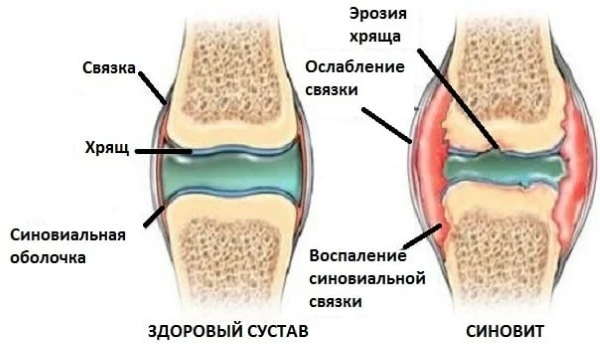
Knee synovitis
It is important to consult a traumatologist or orthopedist in a timely manner. The specialist will conduct an examination, prescribe additional tests and, based on the results obtained, will select the most effective and safe treatment for the patient.
Signs of the disease
Pathological processes provoke the following general clinical symptoms:
- the volume of the joint increases (changes occur within a few hours);
- the patella is running (if you press on it, it sinks under the skin, lets go, returns to its place);
- movement of the joint is difficult, the process is accompanied by severe pain syndrome;
- in some situations, patients complain of high fever;
- a person complains of general weakness in the body, malaise.
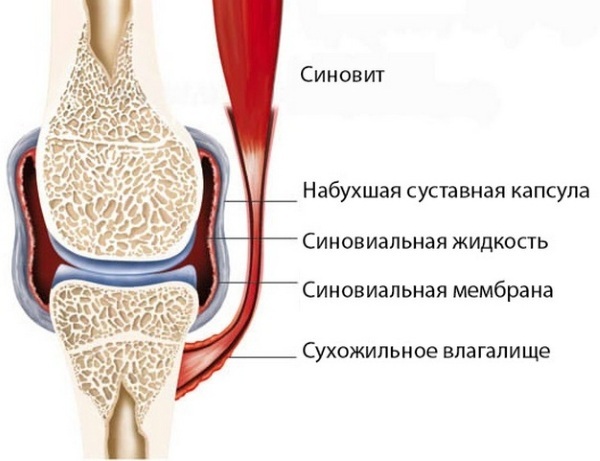
Symptoms of the disease will help determine the stage and degree of development of knee synovitis. It is necessary to go to the hospital, undergo an examination and start treatment in order to prevent possible complications.
Signs of a chronic form
Synovitis of the knee joint (treatment is selected by the doctor after a comprehensive examination, taking into account the test results) of the chronic form proceeds with mild symptoms. The periods of exacerbation are followed by remissions.
For chronic synovitis of the knee joint, the following clinical signs are characteristic:
- the movement of the affected leg is limited;
- a person gets tired quickly when walking;
- painful sensations of an aching character are felt in the knee;
- against the background of progressive pathological processes, a crunch appears in the area of the affected knee joint;
- a person complains of quick fatigability;
- slight effort during movement provokes a dislocated knee.
A doctor's help is needed to make an accurate diagnosis and determine a treatment regimen.
Acute symptoms
The pathological condition is accompanied by pronounced signs:
- the volume of the affected knee joint increases;
- bending and unbending the lower limb is difficult and painful for a person;
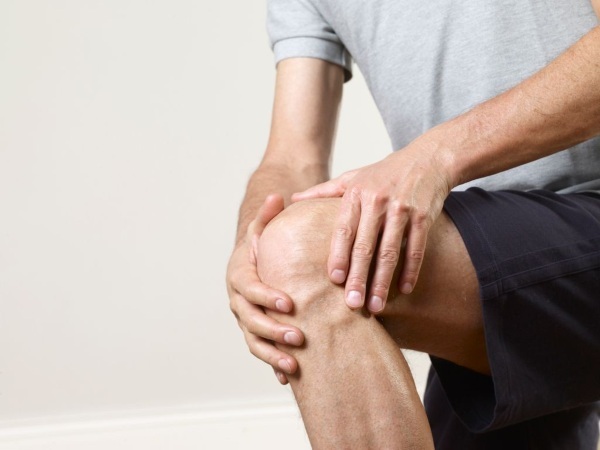
- the skin over the affected joint turns red, heats up, becomes inflamed;
- there is a fever;
- signs of intoxication of the body appear (nausea, general weakness, fatigue);
- consciousness is disturbed, a person has hallucinations, he is delirious.
Without a comprehensive examination and specially selected treatment, acute synovitis of the knee joint progresses and flows into a chronic form.
Possible consequences and complications
Lack of medical care to eliminate the pathological condition will lead to the occurrence of serious complications:
| Name | Description |
| Cartilage destruction | Destructive changes occur against the background of a chronic inflammatory process, which enhances the high level of enzymes. |
| Purulent arthritis | A pathological condition that occurs when an infection enters the joint area. A strong inflammatory process affects all of its constituent elements. There is a high probability of death due to the ingress of bacteria into the blood. |
| Panarthritis | The disease is characterized by the occurrence of an acute purulent process. Pathology affects the joint, ligamentous apparatus and periarticular tissues. |
| Hydrarthrosis | A chronic disease that disrupts the functioning of the musculoskeletal system. The joint increases, its mobility decreases. |
The consequences of knee synovitis depend on the condition of the human body, how quickly medical care was provided. The right therapy is what matters. Severe forms of the disease provoke sepsis, complete immobility of the joint and even the death of the patient.
Diagnostic methods
A comprehensive examination of a knee joint lesion will help to make an accurate diagnosis and choose an effective treatment, guided by the test results. Diagnostic measures and treatment are selected by an orthopedist, traumatologist or surgeon.
For an accurate diagnosis, a specialist prescribes the following tests for patients: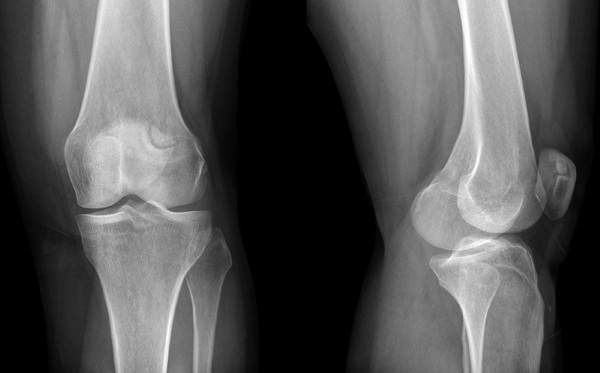
| Name | Description |
| X-ray | A diagnostic method that allows you to determine the underlying disease. Also assess the area of development of degenerative changes and the degree of joint damage. |
| Ultrasound examination (ultrasound) | During the procedure, the doctor carefully examines the affected area of the joint, assesses the degree of development of inflammation, and identifies degenerative processes. |
| Magnetic resonance imaging (MRI) | The examination will help the specialist to determine the accumulation of fluid in the synovial membrane, the expansion of the joint space, the appearance of multiple erosions. |
| Arthroscopy | A medical procedure is used for diagnostic and therapeutic purposes. During the manipulations, the doctor visually determines the pathological changes in the knee joint. |
Biopsy and cytology are performed if a malignant or benign tumor is suspected. Autoimmune diseases, against the background of which synovitis of the knee joint also develops, will help determine allergic tests.
Medication treatment
Knee synovitis (treatment and recovery is supervised by a traumatologist or orthopedist) provides for the use of local drugs and injections:

| Drugs | Name | Application |
| Ointments | Capsicam, Finalgon | The medicine is used externally. Ointment (2-3 g) is rubbed into the affected area with light massage movements 2-3 times a day. The course of therapy lasts 10 days. |
| Gels | Voltaren, Fastum | The medicine is applied to the skin, rubbing lightly, 3-4 times a day. A single dosage for an adult is 2-4 g. The course of treatment is 2 weeks. |
| Injections | Ortofen, Movalis | The drugs are administered intravenously for 3 days. The adult dosage is 7.5-15 mg once a day. The doctor prescribes the scheme and course of treatment, taking into account the symptoms of the disease. |
Ointments and gels relieve pain, reduce inflammation in the knee area.
General principles of synovitis treatment
Complex therapy also involves taking certain medications. Medicines are selected by an orthopedist or traumatologist after a comprehensive examination based on the results obtained. The specialist takes into account the patient's condition, the degree of development of the disease and the individual characteristics of the human body.
Knee synovitis (it is important to start treatment at the early stages of the development of the degenerative-inflammatory process in order to prevent serious complications) provides for the use of the following drugs:
| Drug group | Name | Application |
| Antibiotics | Ceftriaxone, Azithromycin | The medicine is administered intravenously or intramuscularly. Adults are prescribed 1-2 g every 24 hours. |
| Non-steroidal anti-inflammatory drugs | Ibuprofen, Nimesil | Medicines relieve painful sensations, eliminate the inflammatory process. The drug is taken orally after meals with plenty of water. The adult dosage is 400-600 mg 3 times a day, depending on the patient's condition. |
| Glucocorticoids | Hydrocortisone, Dexamethasone | The drugs reduce the swelling of the affected knee joint. Adults are advised to take 0.5-9 mg per day. The dosage is divided into 2-4 doses. |
| Medicines to improve blood circulation | Curantil, Trental | The tablets are taken on an empty stomach by mouth, without chewing and drinking plenty of water. The adult dosage is 75 mg 3 times a day. |
| Chondroprotectors | Structum, Artra | The drugs promote the regeneration of cartilage tissue. The medicine is taken orally with plenty of water. Adults are prescribed 1 g per day. The course of treatment lasts at least 6 months. |
The drugs are selected by a traumatologist or orthopedist. It is important to strictly adhere to the established treatment regimen and dosages. Many components of medicines provoke side effects.
Home treatment
At home, if there are no serious contraindications, for synovitis of the knee joint, you can use the recipes of healers and healers.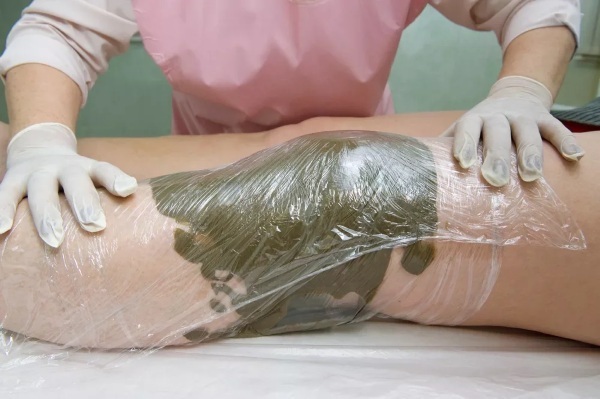
| Name | Recipe | Application |
| Herbal collection | Mix together mistletoe, thyme, birch, eucalyptus, echinacea and tansy in equal parts. Brew 1 tbsp. l. hot water (1 tbsp.), insist 1 hour and strain. | It is recommended to take the finished medicine at 1/3 tbsp. 3 times a day. |
| Medicinal sprinkle | Melt lard (100 g) in a steam bath. Pre-grind the grass and add 0.5 tbsp to the fat. sprinkler. Cool the resulting mixture and store in a cool place. | Ointment is applied to the affected joint 3 times a day. |
| Rubbing | Grind a couple of bay leaves. Add olive oil (1 tbsp.) To it. Insist the resulting mass in a dark place for 2 weeks. | The finished product is used during therapeutic massage. It is recommended to rub the affected knee before bedtime. |
For synovitis of the knee joint, you should also take a tincture prepared on the basis of black walnut. The recommended dosage for the patient is 1 tsp. l. before eating.
Physiotherapy
Comprehensive treatment of synovitis of the knee joint also provides for the implementation of therapeutic exercises. Exercises are selected by a specialist, they should be done under the supervision of an instructor or doctor.
Complex of classes:
- Lie on your back and bend your legs at the knee. Stay in this position for 5 s. Then straighten your legs.
- Lie on a flat surface, face down. Rest your feet against the wall. Strain as much as possible and try to straighten your legs.
- Lie on your back. In this position, it is necessary to lift the affected leg up and try to straighten it.

Therapeutic exercises will help develop the joint, strengthen muscles and ligaments. Exercise has a general positive effect on the human body, making it healthy, increasing its defenses. Physical education should be performed strictly after the exacerbation period subsides.
Physiotherapy
Knee synovitis (treatment is carried out using complex methods) requires the patient to attend physiotherapy procedures. They are prescribed during the rehabilitation period for a speedy recovery.
| Name | Description |
| Medicinal electrophoresis | Constant electric currents are used to influence the human body. Thanks to them, the drug penetrates deep into the tissues, where the inflammatory-degenerative process develops. The active components act directly on the focus of the disease. |
| Magnetic therapy | During the procedure, a statistical or alternating magnetic field is used. The treatment reduces pain syndrome, inflammation in the joint area, promotes resorption of edema and increases the mobility of the affected limb. |
| Tocotherapy | Microcurrent therapy helps to restore the functioning of the neuromuscular apparatus, promotes the regeneration of damaged tissues. Blood circulation accelerates, material metabolism improves. During the procedure, a pulsed electric current is used. |
| Laser therapy | A directed stream of light accelerates the healing process and repair of damaged tissues. |

Treatment is prescribed by a physiotherapist, taking into account the person's condition and the individual characteristics of his body. The procedures improve blood circulation, increase the effectiveness of drug therapy, and promote the early restoration of joint functions.
Leeches
The complex fight against synovitis of the knee joint involves hirudotherapy. Treatment is recommended at the stage of remission, when the symptoms of the disease are mild.
Leeches reduce painful sensations, eliminate inflammation and increase the body's defenses. To achieve the maximum therapeutic effect, hirudotherapy is recommended to be used together with medications. It is important to remember about the contraindications for the procedure.
Puncture
Puncture for synovitis of the knee joint is necessary for the collection of synovial fluid, which, after medical procedures, is sent for research.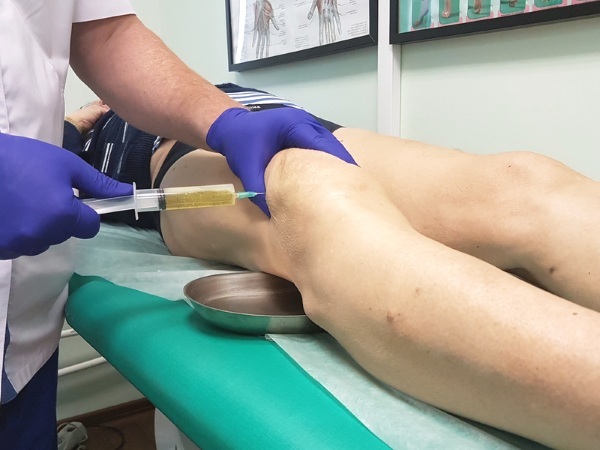 The painless procedure involves inserting a thin needle into the joint cavity.
The painless procedure involves inserting a thin needle into the joint cavity.
Orthopedic mode
Treatment of knee synovitis is aimed not only at eliminating the underlying cause of the disease.
Orthopedic products will help to reduce severe painful sensations:
- semi-rigid orthosis;
- bandage;
- knee pads, which are equipped with metal or plastic special inserts.
In addition to orthopedic products, crutches and walkers can be used while moving.
Operation
Surgical treatment is indicated for patients with synovitis of the knee joint, if the use of medications has not helped to achieve a positive result. Pathological processes progress, the patient's condition worsens, clinical signs intensify.
Surgical intervention is carried out by the following methods:
| Name | Description |
| Arthroscopy | The surgeon performs medical manipulations under the supervision of a small video camera using a minimally invasive method. In the area of the affected joint, the doctor makes 3 punctures through which medical instruments are inserted. During the operation, the specialist removes the accumulated fluid and some parts of the joint capsule. |
| Synovectomy | Surgical intervention involves the removal of the affected part of the synovium. |

After surgical treatment, the patient is shown anti-inflammatory and antibacterial therapy to prevent possible consequences.
Terms of treatment
The fight against synovitis of the knee joint will take from 7 days to 3 months. It all depends on the type of disease and the state of the human body. It is important to go to the hospital when the first clinical signs appear, undergo a full examination and start therapy selected by a traumatologist, orthopedist.
Complications and prognosis
The prognosis of the disease depends on numerous factors, including the timely provided therapy, the state of the patient's body immunity.
In most cases, the patient recovers safely with the restoration of the functioning of the knee joint capsule. Complications arise as a result of the late admission of a person to the hospital, with the development of complex forms of the disease.
To get rid of synovitis of the knee joint, it is important to adhere to all prescriptions of a traumatologist or orthopedist. Otherwise, the symptoms of the disease will intensify, the pathological processes will progress, the treatment will drag on for a long time. In difficult situations, complications appear that cannot be eliminated without surgical intervention.
Video about synovitis
About synovitis of the knee joint:



